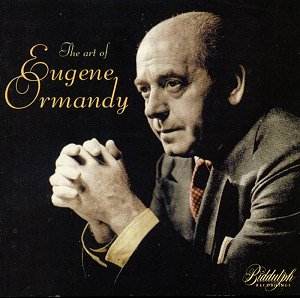I don’t think I’ve ever listened to a series of recordings that so redolently and evocatively depicts the journeys of an orchestral conductor. From band violinist, to aspirant recording soloist, from salon, cinema and theatre orchestras to the Dorsey Brothers’ Concert band and then onwards and upwards first to Minneapolis and then to the peak of Philadelphia - thus was the journey of Jeno Blaü. A student of Hubay in Budapest Blaü joined the European diaspora after the First War, modelling his new surname on the ship that carried him across the Atlantic, the S.S. Normandie. Like many a struggling violinist he gravitated to theatre bands and rose quickly through the ranks. We can hear the first fruits of his recording career in his contract with the small Cameo label in 1923. These relatively late acoustics show a competent, conscientious player though no great tonalist. Five years later he recorded again with his wife, the harpist Stephanie Goldner, this time for Okeh who had a small roster of keen fiddlers on their books, among them the long serving leader of the orchestra Ormandy was later to conduct, Thaddeus Rich of the Philadelphia. His playing here is attractive and gauche in equal measure with salon slides and rather plastic phrasing. In fact the previous year he’d been in the Judson studios – he certainly got around the smaller companies’ thresholds - with a Salon Orchestra giving bold and swaying performances for dancers and turns up conducting the Dorsey aggregation (snobs might like to know that the arrangement is witty and there’s a fine trombone solo).
It was at Minneapolis that Ormandy first made his mark after one or two last minute substitute appearances had convinced talent spotters to back him. The four Minneapolis recordings here are certainly a disparate bunch with Zemachson’s Stokowski-dedicated Choral and Fugue rather too redolent of opportunistic Bachiana and Zador’s Hungarian Caprice playing to the conductor’s native soil, if only superficially. Harris’s quixotic overture is one of his less well-crafted affairs – and Ormandy apparently learned it in an hour on the morning of the recording. The pick is Griffes’s powerfully evocative and Scriabinesque Pleasure Dome of Kubla Khan, emphasising yet again the great loss of his early death. The first disc ends with Ormandy securely at the helm in Philadelphia. If Menotti’s overture is witty and effusive, the Barber Essay is a stunner. The performance is quite remarkably accomplished, perception and authority melded to orchestral brilliance.
The second disc gives us only three composers this time – and no swooning salon strings; Miaskovsky, Strauss and Mahler, albeit a torso. The Miaskovsky is the fabled Twenty First Symphony and receives a superb performance, though there are one or two accelerandi that not all will buy. The recording emphasised the deep, coagulatory Philadelphia basses; when they play sectionally it’s like a volcano rumbling and it can rather overbalance the string ensemble. Still, the portamenti are elegantly discreet, the fugal section brilliant and the overall impression lyrical and effective. About Strauss’s Sinfonia Domestica there can be few complaints. From first to last this is a breath-holdingly fine recording and interpretation. The 1938 sound holds up splendidly. We also have a live Hollywood Bowl Part 1 of Mahler’s Symphony No 8 recorded in July 1948. The sound is constricted and the balance poor and it is really no more than a memento especially given the fact that the remainder seems not to have survived. The women’s voices emerge far better, if stridently, than the men’s – so you’ll have to strain to catch Kullman, London and Mack Harrell.
The Art of Eugene Ormandy is a well-chosen title. It captures him from a jobbing fiddle player to the conductor of one of the most prestigious orchestras in the world, a progress even more accelerated than Barbirolli’s from first desk cellist and quartet player to conductorship in New York. It adds weight and depth to one’s perception of Ormandy, which is otherwise centred inevitably on his marmoreal incumbency with that great orchestra. If you want to know where Ormandy came from, and what he sounded like, here’s your entrée.
Jonathan Woolf


